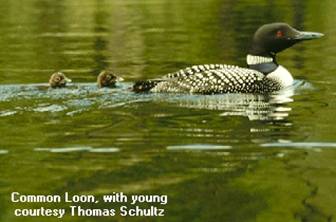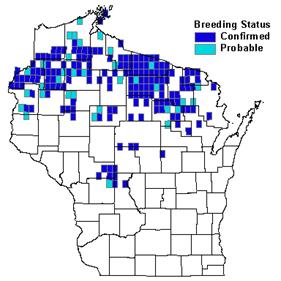

Status/Protection
- Global Rank: G5 Key to global and state ranks
- State Rank: S3S4B
- WBCI Priority: N/A
Population Information
The Federal BBS information can be obtained at http://www.mbr-pwrc.usgs.gov/bbs/bbs.html by clicking on Trend Estimates and selecting the species in question. All estimates are for time period (1966-2005).
- Federal Breeding Bird Survey: significant increase
- Federal Breeding Bird Survey (WI): non-significant increase
- Federal Breeding Bird Survey (BCR 23): N/A
- Federal Breeding Bird Survey (BCR 12): N/A
- WSO Checklist Project: stable (1983-2007)
- LoonWatch: increase; 2005 Wisconsin population estimate of 3,373
Life History
- Breeding Range: Alaska east across Canada and the extreme northern U.S. (McIntyre and Barr 1997)
- Breeding Habitat: Inland Open Water and lakes as small as 4 ha to lakes and impoundments >1000 ha with extensive shorelines, numerous islands, all typically surrounded by forest (McIntyre and Barr 1997).
- Nest: Platform nest built on either aquatic vegetation or mud near waters edge (Ehrlich et al. 1988).
- Nesting Dates: Eggs: early May to late June.
- Foraging: Surface dives (Ehrlich et al. 1988).
- Migrant Status: Short-distance migrant.
- Habitat use during Migration: Rivers, large lakes and reservoirs (McIntyre & Barr 1997, Kenow et al. 2002); continental shelf off the Atlantic Ocean coast (McIntyre 1988, Kenow et al. 2002).
- Arrival Dates: Late March to mid-May (Robbins 1991).
- Departure Dates: Early October to late November (Robbins 1991).
- Winter Range: Coast of Atlantic Ocean from Newfoundland south to Florida and northern Gulf of Mexico. The western population winters along the California coast (McIntyre 1988).
- Winter Habitat: Poorly defined, but primarily sheltered bays, inlets and channels within coastal marine areas (McIntyre and Barr 1997).
Habitat Selection
The Common Loon occurs throughout the northern lakes of Wisconsin and cranberry bogs in the central part of the state (Meyer 2006). It is most commonly found on clear oligotrophic to mesotrophic lakes that contain abundant supplies of small fish, numerous nesting islands, floating bogs, and quiet, secluded areas to rear their chicks (McIntyre 1988). This species may defend a breeding territory of one to three small lakes (4-100 ha) or a section of a larger lake containing extensive, convoluted shorelines (McIntyre and Barr 1997, Piper et al. 2000). It typically forages in areas with good water clarity and minimal to moderate aquatic vegetation density, such as littoral zones, tributary or wetland entrances, or near islands, shoals, and outcrops (McIntyre and Barr 1997). Although oligotrophic lakes may be preferred more than eutrophic lakes because of water clarity and fewer predator fish (e.g., northern pike, muskellunge; Barr 1973), mesotrophic lakes often have more small prey species that both adult and chicks can capture. Thus, prey availability may be the best predictor of Common Loon habitat, along with nest habitat quality.
Nest are typically along undisturbed shorelines of lakes and are commonly placed on small, protected islands, wetland hummocks, or sphagnum mats, (McIntyre and Barr 1997), and occasionally abandoned muskrat houses and beaver lodges (Titus and VanDruff 1981, Belant 1989). Microhabitat features of the nest site typically include moderate overhead cover, wide view of the territory, and a drop-off adjacent to nest to allow underwater access and escape routes (McIntyre 1988, Strong 1985). Nests consist of a mound of vegetation such as submerged aquatic plants, cattail, bulrush, sedge, or sphagnum moss (McIntyre & Barr 1997) and may be surrounded by woody shrubs (Belant 1989). Some nests consist only of a scrape on sand or bare rock or terrestrial plant material gathered around a nest area by an incubating adult once eggs are laid (McIntyre 1988). Nursery areas are located in areas with few predators, abundant prey (i.e., small fish), and minimal wave action (McIntyre 1983, Strong 1985, Belant 1989) and may be used year after year (Strong 1987).
Habitat Availability
Although the Common Loon nested as far south as northern Illinois, Iowa, and Indiana historically, its breeding range has retracted north over the last century due to shoreline development and habitat alterations (Zimmer 1979) as well as reductions in lake water quality and clarity. These disturbances continue to reduce available breeding habitat today, particularly on the lakes of northern Wisconsin.Population Concerns
Large numbers of Common Loons were shot in the early to mid-twentieth century because they were erroneously perceived as a threat to the sport fishing industry. This coupled with the impacts of pesticides, contaminants, toxic chemicals, and acid rain led to population declines (McIntyre and Barr 1997). Today, the North American population appears to be recovering and is increasing across its range (Sauer et al. 2005). In Wisconsin, survey results from LoonWatch, a long-term study sponsored by Northland College, suggests a modest increase in the state population since the mid-1980s. It is considered an uncommon summer resident in the north and was recently documented breeding in 14% of the quads surveyed by the Wisconsin Breeding Bird Atlas (Meyer 2006).
Despite these promising signs, several factors threaten Common Loon populations. Loons are sensitive to elevated mercury levels in lakes because they are a long-lived, obligate piscivore. Chronic exposure to mercury via ingestion of contaminated fish can lead to lower reproductive success, increased chick mortality (Meyer et al. 1998), and behavioral, physiological, and histological changes associated with methylmercury toxicity (Kenow et al. 2003, Kenow et al. 2007a, Kenow et al 2007b). Human recreational activity around lakes reduces available nesting habitat and compromises nesting attempts (Titus and VanDruff 1981, McIntyre and Barr 1997). Lead poisoning through the ingestion of lead sinkers and entanglement in fishing line and nets also are concerns (Sibley 2001).
Recommended Management
Habitat protection and public education are critical to the conservation of this species. Suitable nesting and nursery areas need to be identified and protected from human disturbance. Human use should be excluded from nesting islands May 1 – July 4. Placing artificial nesting platforms in secluded, undisturbed areas may be another viable management option if reproduction is frequently unsuccessful and when it does not disrupt existing breeding territories. Outreach programs should develop interpretive displays to engage local communities in Common Loon conservation and train local volunteers to maintain artificial nest platforms, monitor breeding pairs and chicks, and post warning signs. LoonWatch and Wisconsin Department of Natural Resources both maintain citizen-based monitoring programs for loon conservation.
Federal and state regulatory agencies should enact policies to reduce mercury emissions from coal burning electric generation plants, chlor-alkalai plants, and municipal waste incinerators. Land-use and watershed programs that promote lake water clarity and quality should be encouraged along with efforts to exclude aquatic invasive species from entering breeding lakes. Programs that encourage use of non-lead fishing tackle should be promoted.
Research Needs
Factors affecting reproductive success in Wisconsin require more study, particularly the impacts of shoreline development on habitat quality and prey availability. Information is lacking on post-fledging habitat use, movements, mortality rates, and causes of mortality. Several aspects of Common Loon migration and wintering ecology are not well-studied. For instance, more information is needed of Wisconsin Common Loon migratory routes, important stopover sites along the routes, the status of wintering ground habitat quality, and loon mercury exposure during that time.
Information Sources
- Cornell Lab of Ornithology species account: http://www.birds.cornell.edu/AllAboutBirds/BirdGuide/Common_Loon.html
- LoonWatch: http://www.northland.edu/Northland/Soei/Programs/LoonWatch/
- North American Breeding Bird Survey: http://www.mbr-pwrc.usgs.gov/bbs/bbs.html
- U.S. Geological Survey Loon Study: http://www.umesc.usgs.gov/terrestrial/migratory_birds/loons/cooperators.html
- Wisconsin Breeding Bird Atlas: http://www.uwgb.edu/birds/wbba/
References
- Belant, J.L. 1989. Common loon productivity and brood habitat use in northern Wisconsin. M.S. Thesis, University of Wisconsin-Stevens Point, Wisconsin. 48pp.
- Ehrlich, P.R., D.S. Dobkin, and D. Wheye. 1988. The birders handbook: a field guide to the natural history of North American birds. Simon & Schuster, Inc. New York.
- Kenow, K.P., Meyer, M.W., Evers D.C., Douglas, D.C. and Hines, J. 2002. Use of satellite telemetry to identify common loon migration routes, staging areas and wintering range. Waterbirds 25: 449-458.
- Kenow, K.P., S. Gutreuter, R.K. Hines, M.W. Meyer, F. Fourner, and W.H. Karasov. 2003. Effects of Methyl Mercury exposure on the growth of juvenile common loons. Ecotoxicology 12:171-182.
- Kenow, K.P., Grasman, K.A., Hines, R.K., Meyer, M.W., Gendron-Fitzpatrick, A., Spalding, M., Gray, B.R. 2007a. Effects of methylmercury exposure on the immune function of juvenile common loons. Environmental Toxicology and Chemistry 26: (In Press).
- Kenow, K.P., Meyer, M.W., Hines, R.K., Karasov, W.H. 2007b. Distribution and accumulation of mercury in tissues and organs of captive-reared common loon (Gavia immer) chicks. Environmental Toxicology and Chemistry (In Press).
- Lindsey, A.R., S.S. Gillum, M.W. Meyer. 2002. Influence of lake-shore development on breeding bird communities in a mixed northern forest. Biological Conservation 107:1-11.
- McIntyre, J.W. 1983. Nurseries: a consideration of habitat requirements during the early chick-rearing period in common loon. Journal of Field Ornithology 54:247-253.
- McIntyre, J.W. 1988. The common loon: spirit of northern lakes. Minneapolis: University of Minnesota Press.
- McIntyre, J. W., and J. F. Barr. 1997. Common Loon (Gavia immer). In The Birds of North America, No. 313 (A. Poole and F. Gill, eds.). The Academy of Natural Sciences, Philadelphia, PA, and The American Ornithologists’ Union, Washington, D.C.
- Meyer, M. 2006. Common Loon. In Atlas of the Breeding Birds of Wisconsin (N.J. Cutright, B.R Harriman, and R.W Howe, eds.). Wisconsin Society of Ornithology, Inc. 602pp.
- Meyer, M.W., D.C. Evers, J.J. Hartigan, and P.S. Rasmussen. 1998. Patterns of Common Loon (Gavia immer) mercury exposure, reproduction, and survival in Wisconsin, USA. Environmental Toxicology and Chemistry 17:184-190.
- Piper, W.H., K.B. Tischler, and M. Klich. 2000. Territory acquisition in loons: the importance of take-over. Animal Behavior 59:385-394.
- Piper, W.H., M.W. Meyer, M. Klich, K.B. Tischler, and A. Dolsen. 2002. Floating platforms increase reproductive success of common loons. Biological Conservation 104:199-302.
- Robbins, S.D. 1991. Wisconsin birdlife: population & distribution, past & present. Univ of Wisconsin Press, Madison, WI.
- Sauer, J.R., J.E. Hines, and J. Fallon. 2005. The North American Breeding Bird Survey, Results and Analysis 1966 - 2005. Version 6.2.2006. USGS Patuxent Wildlife Research Center, Laurel, MD.
- Sibley, D.A. 2001. The Sibley guide to bird life and behavior. National Audubon Society. Alfred A. Knopf, Inc.
- Strong, P.I.V. 1985. Habitat selection by common loons. Ph.D. Thesis, University of Maine, Orono. 53 pp.
- Strong, P.I.V. 1987. Reuse of nesting and nursery areas by common loons. Journal of Wildlife Management 51:123-127.
- Titus, J.R. and L.W. VanDruff. 1981. Response of common loons to recreational pressure in the Boundary Waters Canoe Area, northeastern Minnesota. Wildlife Monograph 79. 59pp.
- Zimmer, G.E. 1979. The status and distribution of the common loon in Wisconsin. M.S. Thesis. University of Wisconsin-Stevens Point, Wisconsin. 63 pp.
Contact Information
- Compiler: Dan Haskell, danhaskell@hotmail.com
- Editor: Kim Kreitinger, K.Kreitinger@gmail.com
